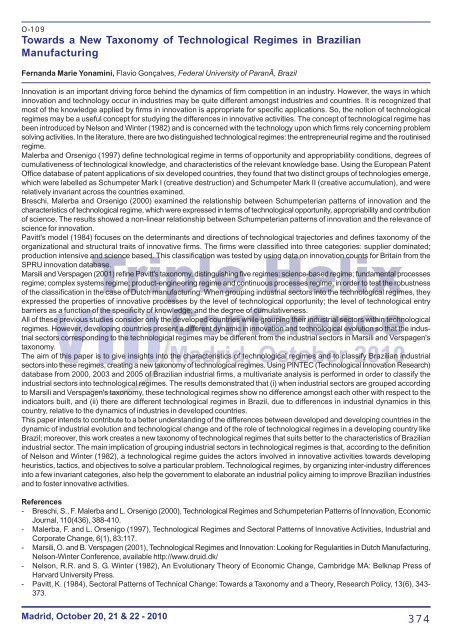TRIPLE HELIX noms.pmd
TRIPLE HELIX noms.pmd
TRIPLE HELIX noms.pmd
You also want an ePaper? Increase the reach of your titles
YUMPU automatically turns print PDFs into web optimized ePapers that Google loves.
O-109Towards a New Taxonomy of Technological Regimes in BrazilianManufacturingFernanda Marie Yonamini, Flavio Gonçalves, Federal University of ParanÃ, BrazilInnovation is an important driving force behind the dynamics of firm competition in an industry. However, the ways in whichinnovation and technology occur in industries may be quite different amongst industries and countries. It is recognized thatmost of the knowledge applied by firms in innovation is appropriate for specific applications. So, the notion of technologicalregimes may be a useful concept for studying the differences in innovative activities. The concept of technological regime hasbeen introduced by Nelson and Winter (1982) and is concerned with the technology upon which firms rely concerning problemsolving activities. In the literature, there are two distinguished technological regimes: the entrepreneurial regime and the routinisedregime.Malerba and Orsenigo (1997) define technological regime in terms of opportunity and appropriability conditions, degrees ofcumulativeness of technological knowledge, and characteristics of the relevant knowledge base. Using the European PatentOffice database of patent applications of six developed countries, they found that two distinct groups of technologies emerge,which were labelled as Schumpeter Mark I (creative destruction) and Schumpeter Mark II (creative accumulation), and wererelatively invariant across the countries examined.Breschi, Malerba and Orsenigo (2000) examined the relationship between Schumpeterian patterns of innovation and thecharacteristics of technological regime, which were expressed in terms of technological opportunity, appropriability and contributionof science. The results showed a non-linear relationship between Schumpeterian patterns of innovation and the relevance ofscience for innovation.Pavitt's model (1984) focuses on the determinants and directions of technological trajectories and defines taxonomy of theorganizational and structural traits of innovative firms. The firms were classified into three categories: supplier dominated;production intensive and science based. This classification was tested by using data on innovation counts for Britain from theSPRU innovation database.Marsili and Verspagen (2001) refine Pavitt's taxonomy, distinguishing five regimes: science-based regime; fundamental processesregime; complex systems regime; product-engineering regime and continuous processes regime, in order to test the robustnessof the classification in the case of Dutch manufacturing. When grouping industrial sectors into the technological regimes, theyexpressed the properties of innovative processes by the level of technological opportunity; the level of technological entrybarriers as a function of the specificity of knowledge; and the degree of cumulativeness.All of these previous studies consider only the developed countries while grouping their industrial sectors within technologicalregimes. However, developing countries present a different dynamic in innovation and technological evolution so that the industrialsectors corresponding to the technological regimes may be different from the industrial sectors in Marsili and Verspagen'staxonomy.The aim of this paper is to give insights into the characteristics of technological regimes and to classify Brazilian industrialsectors into these regimes, creating a new taxonomy of technological regimes. Using PINTEC (Technological Innovation Research)database from 2000, 2003 and 2005 of Brazilian industrial firms, a multivariate analysis is performed in order to classify theindustrial sectors into technological regimes. The results demonstrated that (i) when industrial sectors are grouped accordingto Marsili and Verspagen's taxonomy, these technological regimes show no difference amongst each other with respect to theindicators built, and (ii) there are different technological regimes in Brazil, due to differences in industrial dynamics in thiscountry, relative to the dynamics of industries in developed countries.This paper intends to contribute to a better understanding of the differences between developed and developing countries in thedynamic of industrial evolution and technological change and of the role of technological regimes in a developing country likeBrazil; moreover, this work creates a new taxonomy of technological regimes that suits better to the characteristics of Brazilianindustrial sector. The main implication of grouping industrial sectors in technological regimes is that, according to the definitionof Nelson and Winter (1982), a technological regime guides the actors involved in innovative activities towards developingheuristics, tactics, and objectives to solve a particular problem. Technological regimes, by organizing inter-industry differencesinto a few invariant categories, also help the government to elaborate an industrial policy aiming to improve Brazilian industriesand to foster innovative activities.References- Breschi, S., F. Malerba and L. Orsenigo (2000), Technological Regimes and Schumpeterian Patterns of Innovation, EconomicJournal, 110(436), 388-410.- Malerba, F. and L. Orsenigo (1997), Technological Regimes and Sectoral Patterns of Innovative Activities, Industrial andCorporate Change, 6(1), 83:117.- Marsili, O. and B. Verspagen (2001), Technological Regimes and Innovation: Looking for Regularities in Dutch Manufacturing,Nelson-Winter Conference, available http://www.druid.dk/- Nelson, R.R. and S. G. Winter (1982), An Evolutionary Theory of Economic Change, Cambridge MA: Belknap Press ofHarvard University Press.- Pavitt, K. (1984), Sectoral Patterns of Technical Change: Towards a Taxonomy and a Theory, Research Policy, 13(6), 343-373.Madrid, October 20, 21 & 22 - 2010374










